博文
Some Information about Mid-ocean Ridges
||
Some Information about Mid-ocean Ridges
Lijun Chen
1. The W-type belt of mid-ocean ridges
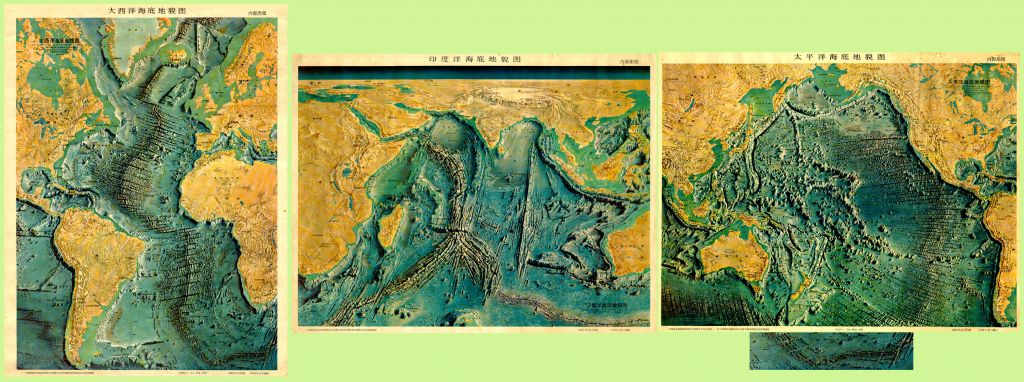
(Frome The Mineral Intelligence Unit: Seafloor Geomorphology.
Research of Geological and Mineral, Vol.1,No.1,1974, P.132-149)
What does the Theory of Seismo-geothemics Explain?
It is said there is a W-type of mid-ocean ridges forming by the Mid-Atlantic ridge,indian ridge and pacific ridge.
2. The map below, which shows the location of mid-ocean ridges and the age of some oceanic bedrock near these ridges.
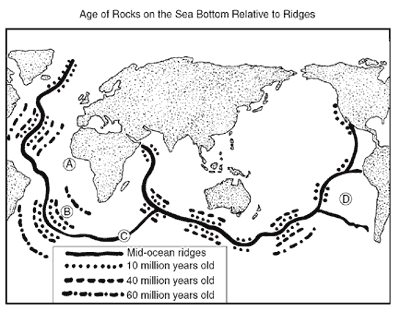
(From From http://www.nysedregents.org/testing/scire/sciarch/psestestju03.pdf)
(From http://rpdp.net/sciencetips_v2/E12C2.htm)
What does the Theory of Seismo-geothemics Explain?
It is said there is a phenomemon of sea-floor spreading by some ridges on the Earth.
3. Age of oceanic crust. The red is most recent, and blue is the oldest.
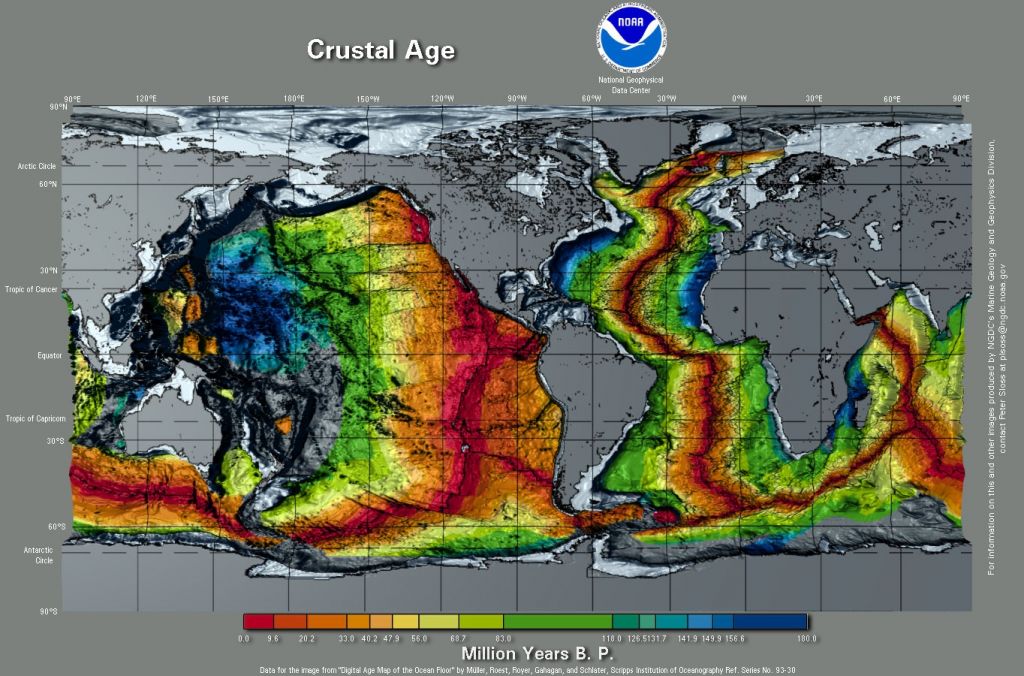
(Frome http://en.wikipedia.org/wiki/Mid-ocean_ridge)
4. Crustal age, sediment thickness
•Recent (1950s) evidence was much more conclusive: Oceanic crustal age, sediment thickness and the presence of a mid-ocean ridge, were all as expected if the crust was pulling apart and new crust was being created at the ridge.
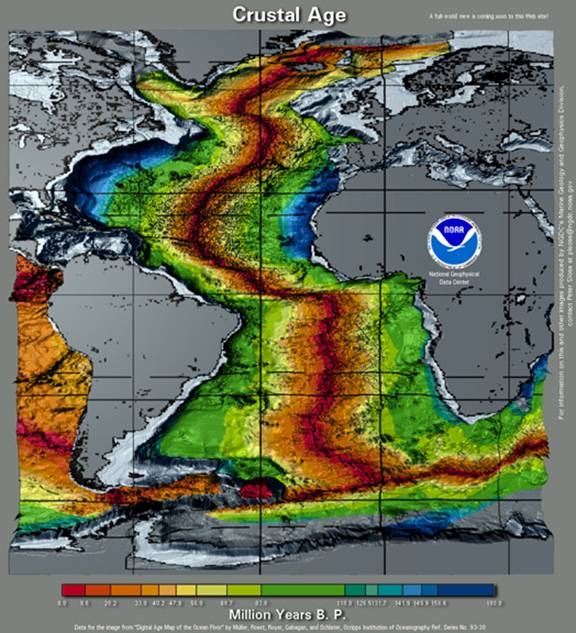
•The invention of magnetometers for locating submarines also provided a boon for geologists in that they were able to detect the weak magnetism of iron-bearing minerals on the oceanic crust. These minerals align themselves with the Earth's magnetic field when they are still in semi-liquid state, leaving a record of the strength and direction of the magnetic field.
•It was discovered that the poles occasionally reverse; that is, the north and south magnetic poles changed positions. When the mid-ocean ridges were examined globally by magnetometers, it was discovered that there was a pattern of symmetrical magnetic stripes parallel to the ridges, which recorded each of the normal and reversed polarity events.
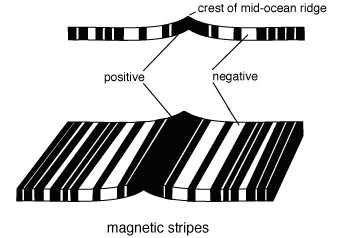
•Each stripe on one side of the ridges was matched by a stripe of equal width and magnetic polarity on the other side, and the pattern was repeated all over the world.
•Seafloor spreading accounts for these magnetic patterns, in that as magma rises from the center of a mid-ocean ridge, iron-bearing minerals are magnetized in the direction of the Earth's magnetic field. The magma cools with the remnant magnetism recorded in its minerals.
•As the lithosphere spreads apart and new material is added at the ridge, the various reverses in the Earth's magnetic field are recorded.
•The magnetic fields in rocks of various continents also suggest that the continents were all in one place. Either that, or the Earth had dozens of poles at the same time.
Earthquakes and trenches
•It was shown that the location of earthquake epicenters occurring near deep-ocean trenches coincided with sloping planes plunging from the trench into the Earth. These epicenters trace out regions where plates are subducting, or diving back into the Earth's interior.
(From http://www.nakedscience.org/mrg/Plate%20Tectonics%20Lecture%201.htm)
What does the Theory of Seismo-geothemics Explain?
(1) The phenomemon of sea-floor spreading by some ridges on the Earth is all right.
(2) “As the lithosphere spreads apart and new material is added at the ridge, the various reverses in the Earth's magnetic field are recorded.”It’s OK?No,it is not record of the Earth's magnetic field but record of sea-floor spreading only. Physically, as magma rises from the center of a mid-ocean ridge and when they are still in semi-liquid state, iron-bearing minerals are magnetized in the direction of reversed polarity of older rocks of ridges on the both of sides.
(3) The deep-ocean trenches are the outcome of earthquakes prohaps becose earthquakes depth 100km and more on the Earth are put together in 24 places which is not in a row along the deep-ocean trenches.
5. Transform fault
John Tuzo Wilson recognized that the offsets of oceanic ridges by faults do not follow the classical pattern of an offset fence or geological marker in Reid’s rebound theory of faulting, from which the sense of slip is derived. The new class of faults, called transform faults, produce slip in the opposite direction from what one would surmise from the standard interpretation of an offset geological feature. Slip along transform faults does not increase the distance between the ridges it separates; the distance remains constant in earthquakes because the ridges are spreading centers. This hypothesis was confirmed in a beautifully simple study of the fault plane solutions that showed the slip on transform faults points in the opposite direction than classical interpretation would suggest.
(Frome http://en.wikipedia.org/wiki/Transform_fault)
6. The spreading rate
The rate at which the mid-ocean ridge creates new material is known as the spreading rate, and is generally measured in mm/yr. The common subdivisions of spreading rate are fast, medium, and slow with values generally being >100 mm/yr, 100–55 mm/yr, and 55–20 mm/yr, respectively. The spreading rate of the north Atlantic Ocean is ~ 25 mm/yr, while in the Pacific region, it is 80–120 mm/yr. Ridges that spread at rates <20 mm/yr are referred to as ultraslow spreading ridges (e.g., the Gakkel ridge in the Arctic Ocean and the Southwest Indian Ridge) and they provide a much different perspective on crustal formation than their faster spreading brethren.
(Frome http://en.wikipedia.org/wiki/Mid-ocean_ridge)
What does the Theory of Seismo-geothemics Explain?
The spreading rate is correspond to the results of GPS data by webset http://sideshow.jpl.nasa.gov/ (see http://blog.sciencenet.cn/home.php?mod=space&uid=552558&do=blog&id=490352).
Therfore the sea-floor spreading is only a slow motion but collision or subduction.
Mid-ocean ridge belt is with the main active layer within the depth of ten kilometers, the inherited motion in the mid-ocean ridge segments caused by the Earth's rotation rate changes result the slow continental drift activities, their activities may be associated with crust material that is away from or opposed to the equator by the angular velocity changes.
(2011.10.16 draft)
https://blog.sciencenet.cn/blog-552558-497441.html
上一篇:The Two Systems of Global Tectonic Activity
下一篇:维权:我为什么中途退出中国地球物理学会第27届年会会场